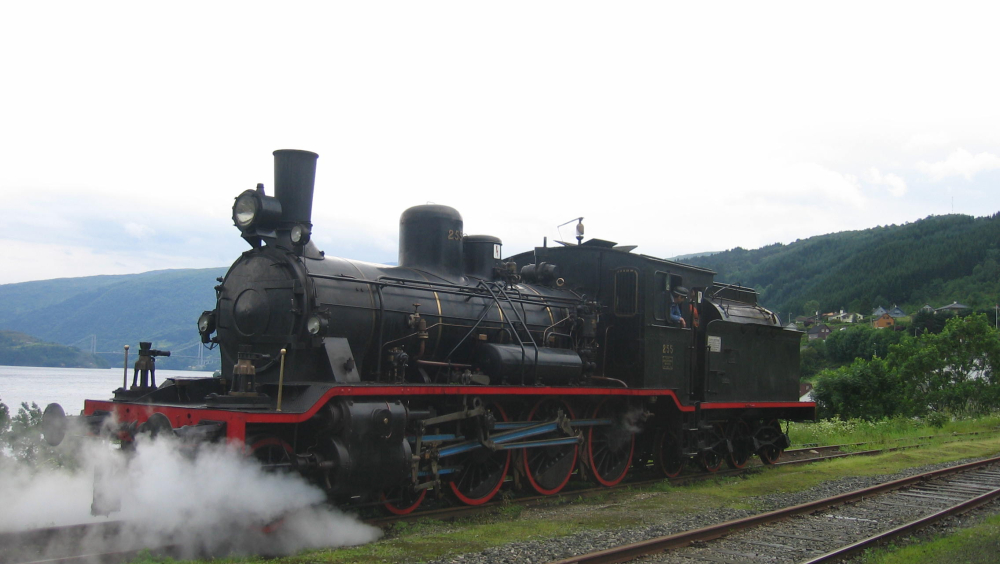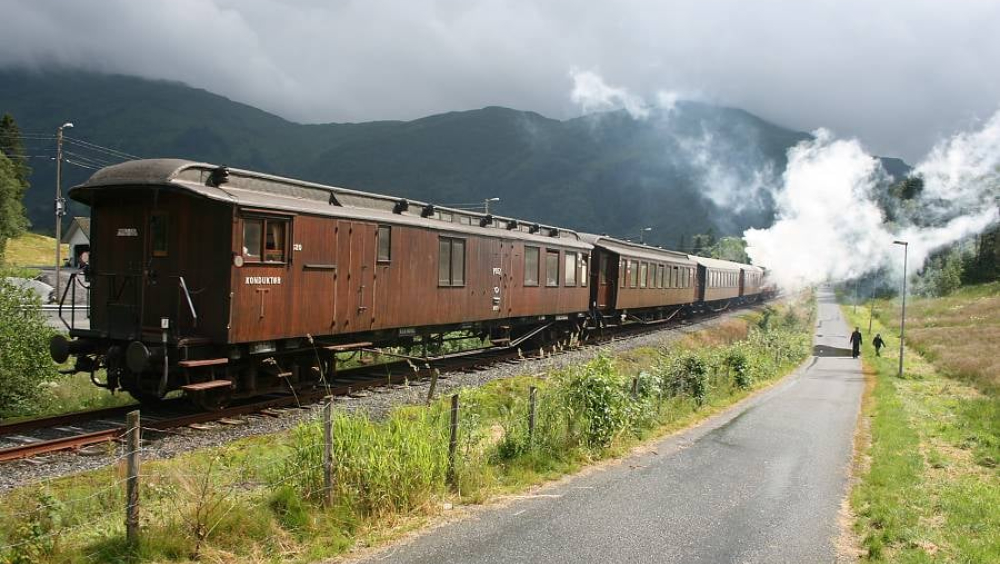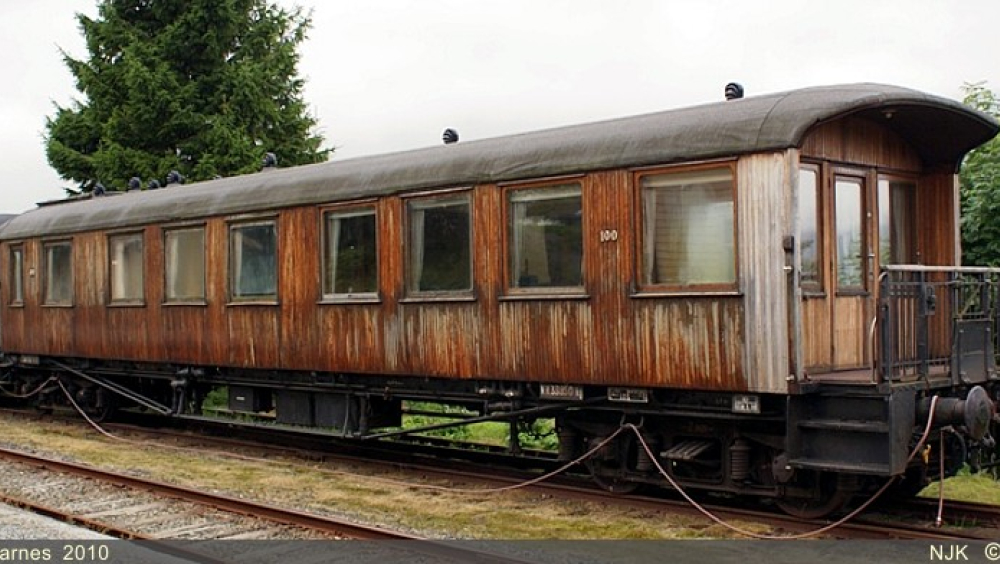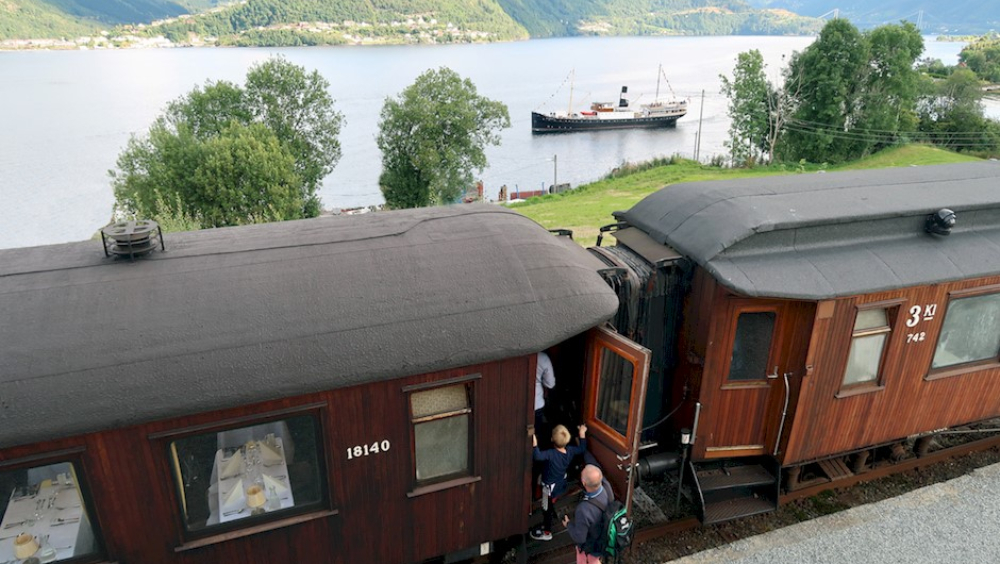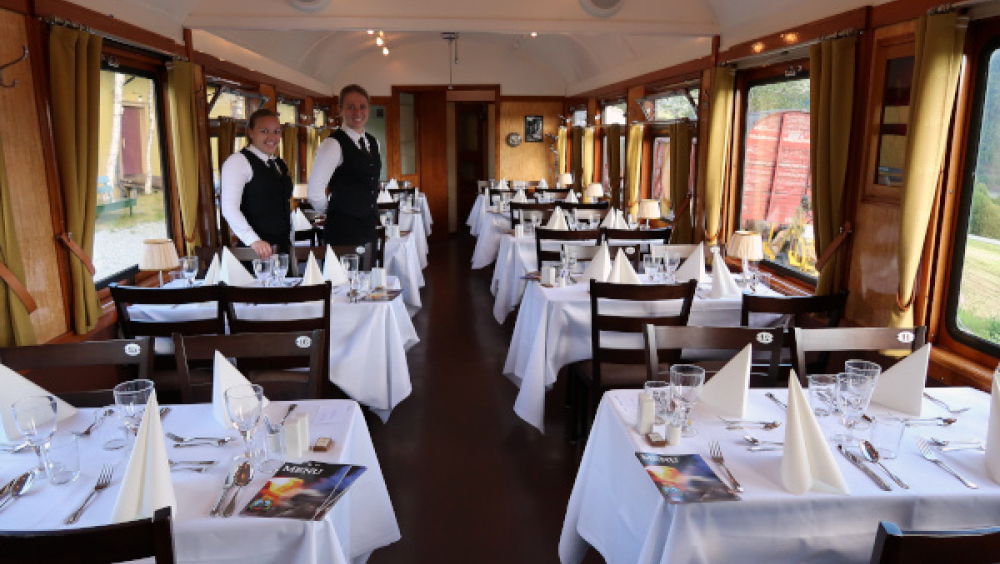Bergen in a Nutshell
This story describes a special heritage round-trip travel in Bergen, Norway's 2nd. largest city, also called the Gateway to the Norwegian Fjords. During this trip one can combine vintage steam boats in the fjords nearby the city of Bergen, with travelling by a vintage steam-powered train with wooden teak-coated passenger coaches through a variety of landscape including tunnels, stone bridges and small charming station villages, all within Bergen Municipal.
BERGEN IN A NUTSHELL (ROUND-TRIP)
Bergen - the inner city harbour in a bright summer day, several vintage buses are waiting for passengers from the vintage steam ship SS Stord, built in 1913, which has just arrived after a sightseeing trip in the fjords in the Bergen region. Tourists either staying in nearby hotels or on some of the huge cruise ships in the harbour, enter the buses. But where will the buses take the traveler’s? After a short trip through Bergen city center passing some of its famous attractions, like the Bryggen wood buildings, today registered in Unesco's World Heritage List, the buses are heading southward to Midttun, about 10 km. south of the city center.
At Midttun, one can see some mostly white smoke from the chimney of a steam locomotive. Behind the locomotive there are six 6 passenger coaches, all with wood bodies. This train is on the current end station at the Heritage Railway Gamle Vossebanen (MGVB), . The train will travel about 18 km eastward on a part of the old Bergensbanen (Oslo Bergen Railway line) Garnes station, which is the other end station for the heritage trains on the line.
After shortening the Bergen railway with two long tunnels in Bergen Municipal in 1964s, a part of the old line became a track solely for freight traffic, but today it is exclusively in use for the vintage trains. After more than 300,000 hours of voluntary work, it has become one of the most attractive museums in this region. These trains are very popular both by tourists and visitors to Bergen as well as the locals.
Let us take a closer look at the vintage train:
The steam locomotive at the head of the train is a Norwegian State Railways (NSB) class 18, carrying the number 255 and was built in 1913. It belongs to the first-generation steam locomotives especially developed for the mountainous Oslo Bergen line.
Behind the locomotive there are totally 6 passenger coaches, all of them with wood bodies coated with the most noble teak panels.
The first coach is no. 620 from 1921, a combined coach with sitting compartments, goods room, an office for the train conductors and most special: A post department with shelves tagged with the names of several of the stations along the Oslo Bergen line, for instance Bergen, Voss, Myrdal/Flåm etc. Today passengers and others visitors can buy railway related post cards and get special stamps on them, and then deliver them in this post compartment for sending their cards anywhere in the world.
The next wooden coach is no. 347, a 3rd. class coach built in 1920. It contains eight compartments and totally 64 seats.
Then follows dining coach no. 18140 from 1937, also with all-wood body. Inside is a very classy and elegant interior with chairs and tables with white clothes and stylish lamps. Here passengers can enjoy a classic and tasteful Norwegian meal while they admire the lovely view through its big windows.
The two next wooden coaches, are typical Norwegian 3rd class coaches with double row of seats divided by an aisle in the middle. Like all the other coaches of this train, they have also big windows for enjoying the view while the train moves forward.
At the rear end of the train is saloon coach no. 100 from 1926. This coach has a very special interior with a room for the attendant and a suite with beds an a bathroom. The rear half of the coach is a meeting room with loose chairs and tables - and larger windows giving an extra good view. There even is an open platform where passengers can enjoy the train ride while getting some fresh air!
After travelling through a variety of landscape with tunnels, bridges and small village stations, all more than 100 years old, the train is arriving at its destination Garnes. Today we are met by a dozen vintage cars, a Volvo Bus from 1937 and motorcycles, some with sidecars,. These vehicles are owned by members of different vintage vehicle clubs. There was a requirement that only vehicles produced before 1940 would be allowed to park at the train station, so they would match the train regarding age!
In addition to watch old vintage vehicles, the visitors can also enjoy the interiors of the buildings at Garnes station with items and pictures from the railway history and miniature models of locomotives and wagons used on the Norwegian railways. In the old freight shed there is a museum store, selling small meals, ice creams, soft drinks, books and souvenirs.
A few minutes walk from the station there is a quay where another heritage steam ship; SS Oster, built in 1908, is waiting for passengers on a round-trip for taking them back to the harbour of Bergen. Other round-trip passengers arrived at Garnes with this ship will take the heritage train back to Midttun.
When the train return to Midttun, 3 vintage buses, mainly from the 1940s, are waiting to bring all the passengers back to their destinations in the Bergen City Center. Everybody agreed this has been a great experience with so many different heritage vehicles - steam train and steam ships, vintage cars, buses, trucks and motorcycles, all of them showing the evolution of transport from 80-120 years ago. Some sporty passengers prefer the short walk from Midttun to Nesttun, then using the City’s modern metro line Bybanen back to the city centre.
Afterword:
Is this a realistic scenario to take place in 2022? Yes, it is because similar trips have been done for years before the pandemic situation due to covid-19 changed for the life for heritage organisations like Museet Gamle Vossebanen as well as it did for lots of the world. Hopefully the pandemic will come to an end this year; then we will be ready to restart again activities like our "Bergen in a Nutshell”-trips. But we truly want to add our most special coaches to the train when this will happen.
Many volunteers are working hard to complete the renovation of the post and passenger coach no. 620 and the saloon coach no. 100, bringing them both back to former glory.
The other coaches already are in regular use on the Gamle Vossebanen heritage railway, mostly in the summer season.Like all vintage rolling stock of this kind, they require regular maintenance. Practically all work on the rolling stock belonging to the Gamle Vossebanen heritage railway are done by volunteering and thus minor labour costs. But material like teak panels, plus many other details which may need to be hand-made, are very expensive. With a very limited income and support, it would be great if our heritage railway Gamle Vossebanen can be granted with a funding from the European Heritage Days, hopefully the maximum possible amount. If we are granted a funding, it is our promise to complete the mentioned rolling stock as soon as possible to make the future trips "Bergen in a nutshell" even more spectacular.
Sincerely yours,
Bjarte W. Nordvik
Museet Gamle Vossebanen
Visitor adr.: Garnes stasjon
Postadr.: Postboks 47 Indre Arna, 5888 Bergen
Tel: +47 - 940 53 037
E-mail: gvb@njk.no
Facebook: https://www.facebook.com/MuseetGamleVossebanen/
web: http://njk.no/gvb/
The Museum Railway Gamle Vossebanen is located in Bergen, in Norway's Westcoast.
With it's more than 950-years history, Bergen has been a natural trading and shipping port with Europe for centuries..With increasing tourism to the region, Bergen is now often called the gateway to the Norwegian Fjords. Visitors from all over Europe and rest of the world enjoy to come and see the great and spectacular nature in the western part of Norway, and for many of those iBergen will be a natural starting point. The city of Bergen offers a lot of attractions to see and explore, and most famous is probably the Bryggen, a collection of old wood buildings from the 17th. century at the sea front in the harbour area. These are now a part of the World Heritage List by Unesco.
